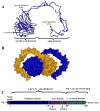How sugars convey information on protein conformation in the endoplasmic reticulum
- PMID: 17997334
- PMCID: PMC2196135
- DOI: 10.1016/j.semcdb.2007.09.006
How sugars convey information on protein conformation in the endoplasmic reticulum
Abstract
The N-glycan-dependent quality control of glycoprotein folding prevents endoplasmic reticulum to Golgi exit of folding intermediates, irreparably misfolded glycoproteins and not completely assembled multimeric complexes. It also enhances folding efficiency by preventing aggregation and facilitating formation of proper disulfide bonds. The control mechanism essentially involves four components, resident lectin-chaperones that recognize monoglucosylated polymannose glycans, a lectin-associated oxidoreductase acting on monoglucosylated glycoproteins, a glucosyltransferase and a glucosidase that creates monoglucosylated epitopes in glycans transferred in protein N-glycosylation or removes the glucose units added by the glucosyltransferase. This last enzyme is the only mechanism component sensing glycoprotein conformations as it creates monoglucosylated glycans exclusively in not properly folded species or in not completely assembled complexes. The purpose of the review is to describe the most significant recent findings on the mechanism of glycoprotein folding and assembly quality control and to discuss the main still unanswered questions.
Figures



Similar articles
-
A sweet code for glycoprotein folding.FEBS Lett. 2015 Nov 14;589(22):3379-87. doi: 10.1016/j.febslet.2015.07.021. Epub 2015 Jul 28. FEBS Lett. 2015. PMID: 26226420 Review.
-
UDP-GlC:glycoprotein glucosyltransferase-glucosidase II, the ying-yang of the ER quality control.Semin Cell Dev Biol. 2010 Jul;21(5):491-9. doi: 10.1016/j.semcdb.2009.12.014. Epub 2010 Jan 4. Semin Cell Dev Biol. 2010. PMID: 20045480 Free PMC article. Review.
-
Role of N-oligosaccharide endoplasmic reticulum processing reactions in glycoprotein folding and degradation.Biochem J. 2000 May 15;348 Pt 1(Pt 1):1-13. Biochem J. 2000. PMID: 10794707 Free PMC article. Review.
-
Protein glucosylation and its role in protein folding.Annu Rev Biochem. 2000;69:69-93. doi: 10.1146/annurev.biochem.69.1.69. Annu Rev Biochem. 2000. PMID: 10966453 Review.
-
Retention of glucose units added by the UDP-GLC:glycoprotein glucosyltransferase delays exit of glycoproteins from the endoplasmic reticulum.J Cell Biol. 1995 Aug;130(4):771-9. doi: 10.1083/jcb.130.4.771. J Cell Biol. 1995. PMID: 7642696 Free PMC article.
Cited by
-
Glucosidase II and N-glycan mannose content regulate the half-lives of monoglucosylated species in vivo.Mol Biol Cell. 2011 Jun 1;22(11):1810-23. doi: 10.1091/mbc.E11-01-0019. Epub 2011 Apr 6. Mol Biol Cell. 2011. PMID: 21471007 Free PMC article.
-
Agl24 is an ancient archaeal homolog of the eukaryotic N-glycan chitobiose synthesis enzymes.Elife. 2022 Apr 8;11:e67448. doi: 10.7554/eLife.67448. Elife. 2022. PMID: 35394422 Free PMC article.
-
Hydrophobicity of protein determinants influences the recognition of substrates by EDEM1 and EDEM2 in human cells.BMC Cell Biol. 2015 Feb 6;16:1. doi: 10.1186/s12860-015-0047-7. BMC Cell Biol. 2015. PMID: 25655076 Free PMC article.
-
The cotranslational maturation program for the type II membrane glycoprotein influenza neuraminidase.J Biol Chem. 2008 Dec 5;283(49):33826-37. doi: 10.1074/jbc.M806897200. Epub 2008 Oct 10. J Biol Chem. 2008. PMID: 18849342 Free PMC article.
-
YesU from Bacillus subtilis preferentially binds fucosylated glycans.Sci Rep. 2018 Sep 3;8(1):13139. doi: 10.1038/s41598-018-31241-8. Sci Rep. 2018. PMID: 30177739 Free PMC article.
References
-
- Alonso JM, Santa-Cecilia A, Calvo P. Effect of bromoconduritol on glucosidase II from rat liver. A new kinetic model for the binding and hydrolysis of the substrate. Eur J Biochem. 1993;215:37–42. - PubMed
-
- Arnold SM, Kaufman RJ. The noncatalytic portion of human UDP-glucose:glycoprotein glucosyltransferase I confers UDP-glucose binding and transferase function to the catalytic domain. J Biol Chem. 2003;278:43320–8. - PubMed
-
- Baksh S, Michalak M. Expression of calreticulin in Escherichia coli and identification of its Ca2+ binding domains. J Biol Chem. 1991;266:21458–65. - PubMed
-
- Bouvier M, Stafford WF. Probing the three-dimensional structure of human calreticulin. Biochemistry. 2000;39:14950–59. - PubMed
-
- Cannon KS, Hebert DN, Helenius A. Glycan-dependent and -independent association of vesicular stomatitis virus G protein with calnexin. J Biol Chem. 1996;271:14280–4. - PubMed
Publication types
MeSH terms
Substances
Grants and funding
LinkOut - more resources
Full Text Sources

